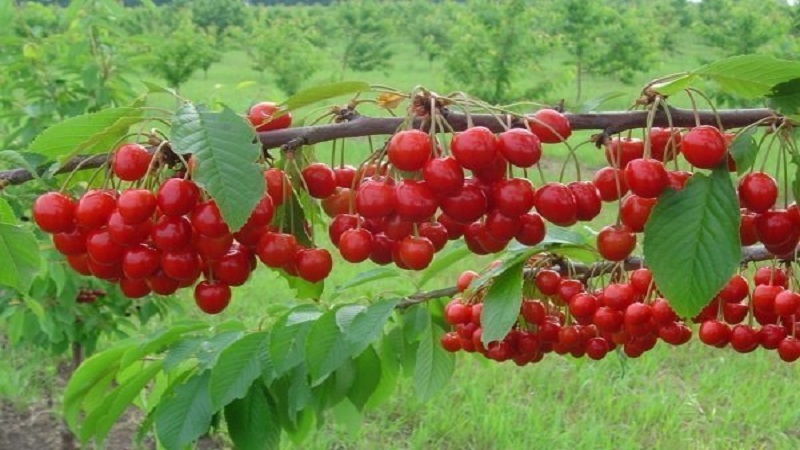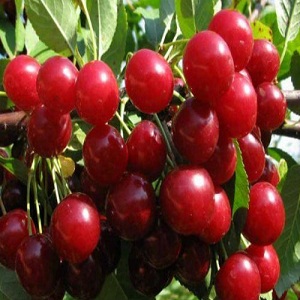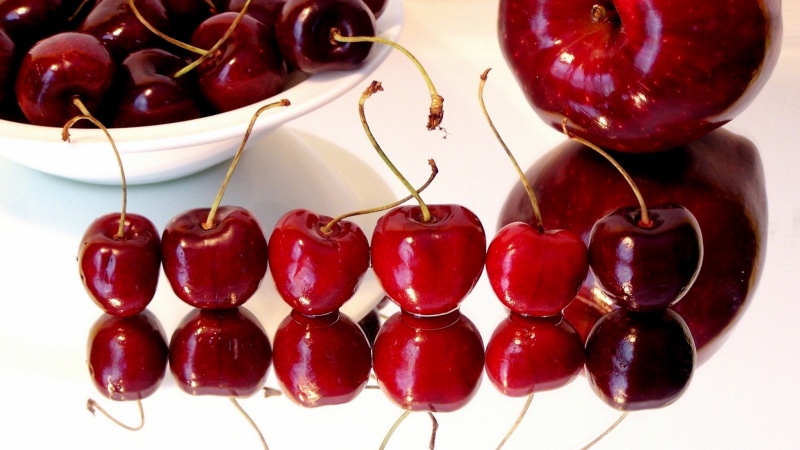What are good cherry and sweet cherry hybrids and what are their features
Someone likes sour-tart cherries, and someone loves honey-sweet cherries. However, there is an intermediate option - the fruits of a cherry-cherry hybrid called duke. The culture has inherited the best characteristics of its "parents" - strong immunity to fungal diseases, frost and drought resistance. Fruits with tender and juicy pulp have a pleasant sweet and sour taste. Today we will tell you about the botanical features of cherries and how to grow them.
The content of the article
Cherry and cherry hybrid
Duke, or sweet cherry (a hybrid of sweet cherry and cherry) was born in England in the 17th century. by pure chance - due to the over-pollination of these crops. The gardeners liked the result so much that breeders began to breed different varieties of crops.
Cherries and sweet cherry - biologically related crops, often growing in neighboring gardens and interbreeding with each other. Most of these plants do not bear fruit, despite the abundant flowering. However, there are fruiting specimens - those very successful duke hybrids.
Cherry cells contain 32 chromosomes, sweet cherries - 16. Cherry is a result of cell division disorders and contains 32 chromosomes. From a genetic point of view, the duke is closer to the cherry, which manifests itself in external signs and taste.
In the photo - the fruits of the Duke.

History of origin and distribution
The first hybrid began to be cultivated in England and was named "May Duke", which literally means "Duke of May" in English. It did not differ in winter hardiness and bore fruit once every 2-3 years. In domestic horticulture, the hybrid is known as the English Early.
At the beginning of the XIX century. the hybrids Empress Eugenia and Queen Hortense also appeared by chance.
In tsarist Russia, I. V. Michurin was engaged in the cultivation of sweet cherries. In 1888 he bred the first duke by crossing Belle cherry and Winkler white cherry. The cultivar received the name Krasa Severa because of its amazing winter hardiness and was intended for cultivation in Siberia. However, this hybrid did not live up to expectations - flower buds died in severe frosts, which significantly reduced productivity.
40 years later, in 1926, Michurin bred the Black consumer goods variety. Over time, it stopped growing due to irregular yields. Small fruits had an almost black color, were distinguished by a high sugar content and cherry flavor.
The rossoshansk breeders (Voronezh region) took over the cultivation baton. In the 30s. last century, they began to actively develop new varieties.
In Melitopol (Ukraine), the fruitful varieties Melitopolskaya Joy and Miracle Cherry were bred, which are still grown in private gardens. The authorship belongs to A.I. Taranenko.
Appearance and taste

In the southern regions and regions with mild winters, trees with a spreading crown are formed. In the northern regions and Siberia, bush-shaped trees are grown.
Outwardly, cherry is an average version of both crops, but the taste of the fruit is closer to cherry.
The leaf blade of a rich green color, larger than that of a cherry, resembles cherry leaves, with a noticeable shine and a denser structure. The petioles are long.
The fruits are formed on short stalks and bouquet branches, are large in size.Average weight - 10 g, maximum - 20 g. The structure of the pulp is the same as that of cherry fruits. The sugar content is similar to that of sweet cherries, but a large amount of acids slightly impairs the taste. The fruits hang on the branches for a long time. In this case, the taste characteristics only improve. The taste is sweet and sour, herbaceous, delicate, with a refreshing aftertaste.
The central trunk and shoots are smooth, like a sweet cherry... The bark is dark brown in color. Skeletal shoots are sometimes located at an acute angle to the central trunk.
In the middle lane, flowering begins at the end of June, in the southern regions - in May. Flowers of white or white-pink shades are collected in inflorescences in the form of bouquets.
Cherry is a fast-growing crop and, if suitable pollinators are available, gives the first harvest in the third year. At the end of flowering, non-pollinated flowers fall off.
Biological features
Cherry is a stone fruit culture that has received the best characteristics from the "parents". Most varieties are self-fertile, but abundant flowering makes it a desirable ornamental crop.
Sharp temperature fluctuations, sudden frosts, heat negatively affect the formation of eggs and pollen. The number of flowers capable of pollination is reduced to 1%. In some cases, sex cells are not formed.
Under optimal conditions of development, only 5% of flower buds are literally hung with large fruits.
Cherry does not tolerate loneliness because of self-infertility. Experienced gardeners recommend planting trees next to cherries and cherries. Dukes do not cross with each other.
Pollination
The best pollinators for Duke:
- Nurse - cherry varieties Podbelskaya and Vstrecha, cherries Valery Chkalov and Large-fruited.
- Ivanovna - Cherry Minx, cherries Franz Joseph and Large-fruited.
- Hope - Cherries Black large, Kent and Lada, cherry Large-fruited.
- Griot Melitopol - Cherry Meeting and Expectation, Vinka cherry.
- Toy - cherries Samsonovka and Minx, cherries Large-fruited, Valery Chkalov, Franz Joseph.
Cherry seedlings are recommended to be purchased in conjunction with pollinators that are capable of pollinating 1/3 of the flowers. This guarantees a bountiful harvest.
Advantages and disadvantages
The benefits of culture:
- High yield - 15-17 kg of fruits from one tree.
- Frost resistance of most varieties with a dominant cherry.
- Drought and heat resistant.

- Pleasant taste and attractive appearance
- Decorativeness of trees due to abundant flowering.
- Resistant to fungal diseases and insects.
- Ease in leaving.
The disadvantages of the culture are minor:
- Trees bear fruit abundantly for the first 3-5 years, then productivity drops sharply. After 8-10 years, flower buds are formed only on short shoots.
- Some varieties (for example, Rubinovka) have a low level of frost resistance, since they took this trait from cherries.
- If the flowering coincides with the spring frost, more than 70% of the flowers become sterile.
- The fruits do not tolerate long-distance transportation - the thin skin is not able to protect the delicate pulp, therefore it quickly softens and leaks.
- Trees need regular pruning due to the vigorous shoot growth.
Dukes varieties
Popular varieties of cherries depending on the ripening period:
- ultra early: Pren Coray, Strong, Miracle cherry;
- mid-early: Saratov baby, Yaroslavna's daughter, Rubinovka, Melitopol Joy;
- mid-season: Hodos, Spartan, Dorodnaya, Nurse, Fesanna;
- mid-late: Ivanovka, Nochka, Excellent Venyaminova, Dorodnaya, Pivonya, Donetsk Giant, Donetsk Shpanka.
Growing regions
Sweet cherry is grown in the Central Black Earth, Central, North-West, South regions, in Western Siberia and the Volga region.
The varieties Fesanna, Nadezhda, Excellent Venyaminova, Pamyati Vavilova, Krepkaya, Mayak, Zhukovskaya have been tested and recommended in the Khabarovsk Territory.
Particularly winter-hardy varieties Spartanka and Ivanovna tolerate frosts down to -25 ... -35 ° C.
Growing features
Cherries are undemanding to care and only need abundant watering in the first years after planting, protection from rodents and severe frosts, sanitary and rejuvenating pruning of branches.
Landing
The duke is planted in small groves. This is the most optimal planting method in terms of aesthetics and ease of maintenance. The place is chosen from the sunny side of the site, protected from gusty winds and drafts. The sun's rays should illuminate the seedlings throughout the day.
Cherry does not grow in wetlands. For landing they select a site on a small hill, with a deep bed of groundwater (no higher than 2 m from the surface).
Planting material is recommended to be purchased at specialized retail outlets or farms engaged in the propagation of seedlings. Each of them should have a tag with information about the age, variety, desired pollinators.
Signs of a healthy seedling:
- age - 2-3 years;
- the trunk is straight, without damage, with a developed rhizome;
- roots with a transverse incision are white;
- the bark is evenly colored, without damage and gum drips.
They are planted in spring and autumn in soil with neutral acidity (pH = 7). Sour soil is normalized with lime - 0.8-1 kg is applied to one pit.
When preparing pits, it is undesirable to get carried away with fertilizers - cherries cannot stand an excess of mineral and organic substances. Over-fertilization leads to rapid growth, the seedlings do not have time to prepare for wintering. The wood does not ripen, the trees freeze over in winter. Proper preparation for wintering is a guarantee of the safety of trees at -35 ° C. When growing dukes on nutritious soil, it is also better not to apply fertilizer.
Pits are placed every 5 m so that the crown of old trees does not shade young seedlings and does not intertwine with branches.
When planting, make sure that the root collar remains above the ground level. Deepening stops the development of seedlings.
Care
When planting on depleted soil, 300 g of superphosphate, 300 g of potassium sulfate, 500 g of wood ash, or 10 liters of compost or humus are placed in each pit. Fertilizers are mixed with the top layer of soil.
After planting, the seedlings are watered - 20 liters each. Watering frequency is 2-3 times a month until the development of a strong rhizome. The crop is resistant to drought, so mature trees do not need watering.
If necessary, young seedlings are fed twice a season:
- first top dressing perform until the end of June - 15-20 g of nitrogen fertilizers for a seedling;
- the second - in the fall with potassium-phosphorus fertilizers (50 g of superphosphate, 30 g of "Nitrofoski").
The powerful root system independently provides the fruit-bearing tree with nutrients. Watering and feeding is reduced or completely stopped.
A lack of oxygen has a detrimental effect on the root system. To improve aeration, the soil around the trees is loosened, weeds are removed, watered and mulched with hay, peat, fallen leaves. A layer of mulch protects the roots from frost and rodents.
The first pruning is performed after planting - the seedlings are shortened by 60-70 cm. The central conductor is left 20-25 cm above the side branches. Strong, well-developed lateral branches are cut by 1/3, weak ones are cut into a ring.
Thickening of the crown reduces the productivity of the duke. Sanitary pruning is performed every year - the tops of the skeletal branches are removed. Anti-aging pruning is carried out 5-6 years after planting.
Protection against diseases and pests
Cherry has strong immunity to most diseases and pests. The plant is not susceptible to moniliosis and coccomycosis, while cherry trees die from them.
The dukes are not afraid of the cherry fly either.
Reproduction
The culture is propagated by cuttings, grafting and layering. The seed method is not used as inexpediency - as a result, a completely different variety is obtained.
Cuttings are performed in late August - early September. Lignified cuttings are suitable for this purpose. They are harvested from the lower branches.The sections are treated with charcoal. The cuttings are kept in a growth stimulator for 3-4 hours, after which they are rooted in pre-prepared holes. The beds are pre-dug up and fertilized with compost or humus. After rooting, the cuttings are covered with a film. Care involves regular watering and the introduction of organic-mineral fertilizers.
Reproduction by grafting is used to obtain more productive trees. The procedure is performed in April, when the active movement of sap in the trees begins.
First, they select strong, winter-hardy varieties of cherries and cherries. A healthy kidney with a shield 30 cm long is carefully cut from a green cutting.Then a bark of the same length is cut into the rootstock, the cutting is applied and fixed with tape or tape so that the kidney remains at the top. For better engraftment, greenhouse conditions are created at the junction - they are covered with plastic wrap.
Wintering
The winter hardiness of the cultivar is higher than that of the sweet cherry, but lower than that of the cherry. In the north of the country, cherries are covered with agrofibre or dense plastic wrap, spruce branches or burlap. The trunk circle is mulched with straw or peat to protect it from temperature changes. In southern Russia, trees do not need shelter from the cold.
In winter, young trees are provided with protection from mice - poison for rodents is poured into the trunk circle. Spruce branches will help protect trees from hares.
Reference. Lapnik is branches of coniferous trees (spruce, pine, fir), which are used to protect plants in winter from a piercing cold wind, severe frosts, sleet and freezing rain. The branches shade trees from the scorching winter sun and provide additional ventilation. Hares and mice avoid such shelters.
Harvesting and application of the crop

The fruits are recommended to be picked together with the stalk. This allows longer storage times, especially if the product is intended for transport.
Harvesting is carried out in the second decade of June - early July. For fresh consumption, fruits that have reached full ripeness are removed, for canning - in 4-5 days, for transportation - in 1.5 weeks.
Cherries are best suited for fresh consumption and further processing. Compotes, jams, preserves, marshmallows are cooked from the fruits, dried and frozen.
Reviews
Sweet cherry is grown in many regions of the country, but it is in the south and in the Central Black Earth Region that it is most popular. Gardeners leave mostly positive reviews about the culture.
Ivan, Stavropol: “In my garden, the Miracle Cherry grows in close proximity to the cherries - at a distance of at least 10 m. There are no problems with cross-pollination, bees also help with this. Last year, most of the cherry trees were affected by moniliosis, but the ducks remained intact. "
Evgeniya, Liski: “I didn’t know what a duke was, what it was crossed with. On the recommendation of a neighbor, four years ago I planted a duke of the Nadezhda variety and I can't get enough of it. The tree is lush and produces an excellent harvest of bright red fruits. Their taste is pleasant, with a pronounced cherry sourness. The pulp is tender and juicy. I make jam from them and cover the compotes for the winter. "
Conclusion
Duke is a hybrid obtained by successful cross-pollination of cherries and cherries. The culture is self-fertile, so it is recommended to plant it next to suitable pollinators.
Resistant immunity to fungi, drought and frost resistance, ease of maintenance make the duke desirable in the gardens of many regions of Russia. The amount of sugars and acids in fruits depends on the dominant - cherry or cherry.